Cristian wants to eat the doughnut in his hand. But he’s failing. Terribly. Not by his own fault, though. The BMW X3 our photographer is passenger in is more to blame. As we belt up Mount Donna Buang, a few hours east of Melbourne, each corner arrives just in time to rip it away from his gaping maw, the huge centrifugal forces proving this X3 is much more than a high-riding family wagon on fancy wheels.
That’s because this is the brand-new M version. Of course, that letter and this car are not the most natural pairing. A few decades ago we’d imagine engineers in Munich headquarters would strangle product planners for even suggesting the idea. But the market demands more performance SUVs than ever. Sales are so lucrative BMW M predicts the X3 will become its best-selling car. Even better than the M2.
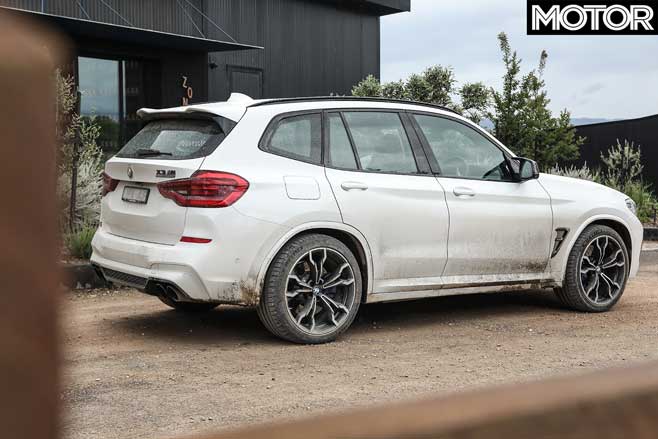
The X3 M scores some serious weapons to help get the job done and out here, on these corners, they seem to be working – especially in range-topping Competition trim. Michelin Pilot Sport 4 S boots lend enough grip to enter a bend without touching the brakes. The nose, perched high off the ground, tenaciously tracks your intended line. It’s so much more hunkered down than the regular X3 that it feels like a completely different car.
The thing is, after going over what’s changed (and the $157,900 price!) it basically is. And one squeeze of the throttle reinforces that. Its nose harbours the all-new S58 engine we’ll see in the next M3 and M4. Twin turbos pressurise an inline-six to produce 600Nm. And with a forged crankshaft, closed-deck block and 3D-printed cylinder head, the new three-litre is good for 375kW. But then there’s the rest of the story.
Grunt is squeezed through an eight-speed transmission and xDrive system from the M5 before reaching all four wheels. It has an active rear differential, adaptive dampers, extra engine bay bracing and an M-specific steering rack. Then there are the brakes, which include beefed-up four-piston front calipers and drilled discs to haul down its two tonnes.
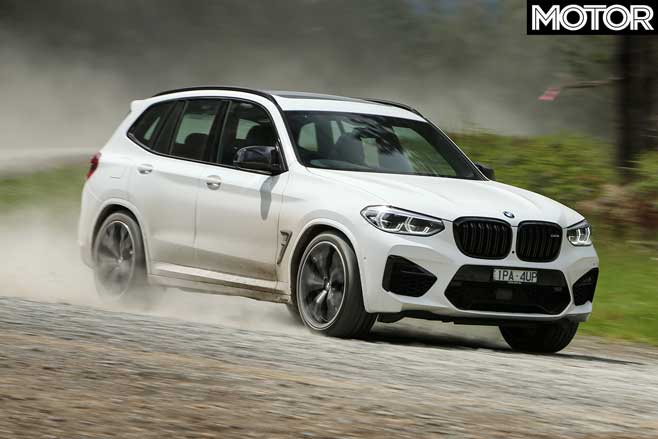
These parts create an SUV that feels as rapid as anything I’ve driven up here. As for Cristian’s doughnut, he’s given up. The coffee in his other hand threatening to erupt over the interior has taken top priority. My concern, meanwhile, is what’s ahead of us – a silver Jaguar F-Pace SVR. It’s a reminder that if BMW wants the X3 M Competition to be as popular as it hopes, it will need to vanquish a broad set of rivals.
Naturally we’d have the updated Mercedes-AMG GLC 63 and Porsche Macan Turbo ready for battle, but since they weren’t available at the time, they’ll ambush the emerging winner in a later comparison. Think of today as the first round before the winner earns a ticket to the final. It won’t be easy.
Like the X3 M, Jaguar has stuffed the F-Pace SVR with as much go-fast engineering as it can handle. Within its engine bay a supercharger wraps a belt around a five-litre V8’s crankshaft. It’s good for 405kW and 680Nm. It then pushes that through an eight-speed transmission to all four wheels, while an active locking rear differential then distributes torque across the rear axle. It costs $142,200 – the cheapest base price here – but the list of goodies keeps going.
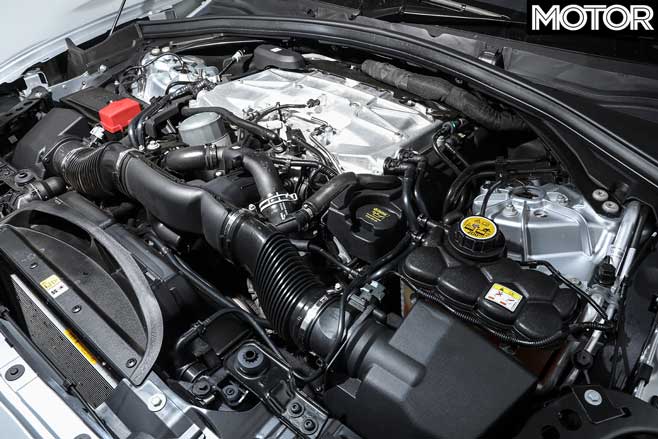
At each corner huge 22-inch optional wheels make dinner plate-sized brake discs look small. And as we buck and bump along the road towards Mount Donna Buang, the SVR’s stiffer springs, roll bars and dampers help settle its massive weight. There are also gleaming exhaust tips pouting from the rear valance, revealing the lightened SVR exhaust system. You will hear this thing well before you see it. And you could say the same for our final contender, which delivers looks and noise in equal measure.
The Alfa Romeo Stelvio might be the brand’s first SUV, but the four-leaf clovers on its guards reveal it always had a fast one in mind. Dubbed the Q (for Quadrofoglio), it splits the other two on price at $149,900 and shares many of its parts with the Giulia Q. That Ferrari-inspired twin-turbo V6, for example, is straight from the sedan with the same 375kW and 600Nm. And the similarities don’t end there.
It rides on 20-inch wheels of the same beautiful telephone-dial design seen on the Giulia, and the brake discs and caliper specs are identical. Even its eight-speed transmission has the same gear ratios. It also gets an Alfa Active suspension system controlled through a drive mode selector. Think of it as a Giulia Q on stilts with a (slightly) bigger boot and all-wheel drive grip, because it certainly drives that way.
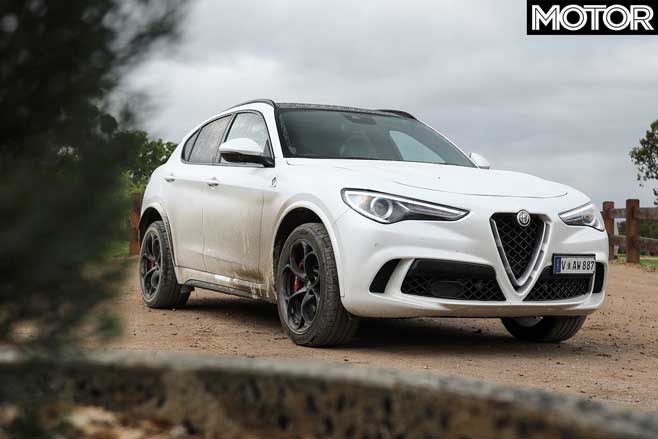
The Stelvio’s chassis breathes with the road, rather than beating it into submission like the X3 M. Amazingly, it retains the Giulia’s signature suppleness, even though it bears another couple hundred kilograms on its bones and holds them higher above the road.
This composure belies the slightly numb brakes. They’re operated by electronic wire, just like the Giulia Q – there is no mechanical connection between pedal and pad – and require a delicate foot like they’re carbon-ceramics that need some heat to work properly. And, keeping true to this theme, they come alive with more speed.
Pluck the sabretooth-sized gear paddle on the left to downshift and the revs spike and reveal that the engine’s bottom-end thrust is just as vicious in the Stelvio. It’s just a shame you can only access the exhaust’s real growl in Race, which turns off ESP and the soft damper setting. When the next corner arrives we squeeze the brake pedal. Hard. And suddenly they bite with feel. Being a lighter vehicle than the other two would no doubt also help.
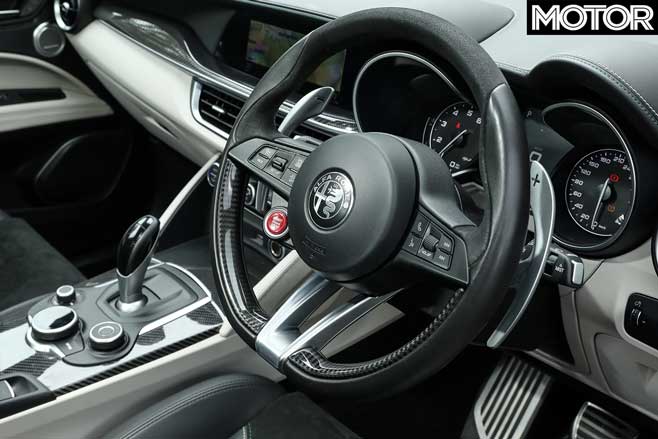
This is a seriously impressive point-to-point device. The steering rack is razor sharp and quick. And the front-end sniffs out the apex before you’ve even thought of turning in. Its light controls and fast reflexes fool you into believing it’s even lighter than it is. But once taken it to the limit, where the rear inside tyre will hop as it fights to put down power, you’ll feel its clever hardware strain against physics’ demands.
The Jaguar, meanwhile, very much serves physics. As well as being the heaviest of the three, the F-Pace is also the softest. There’s a sponginess to it that implies it uses rubber-rich suspension. Perched higher than its rivals, it also needs an extra moment to respond and some extra care when being hustled. Stomp the throttle and that engine amplifies the oscillations… as well as the theatre.
The thunderous noise from the Jaguar’s exhaust sounds like an elephant and lion roaring down a drain pipe at each other. It’s only a shame the transmission is not as sharp. For a start, the paddles are hidden behind the steering wheel spokes and feel soggy to pluck. And the torque converter is lazy, if not downright reluctant, to downshift into lower gears.
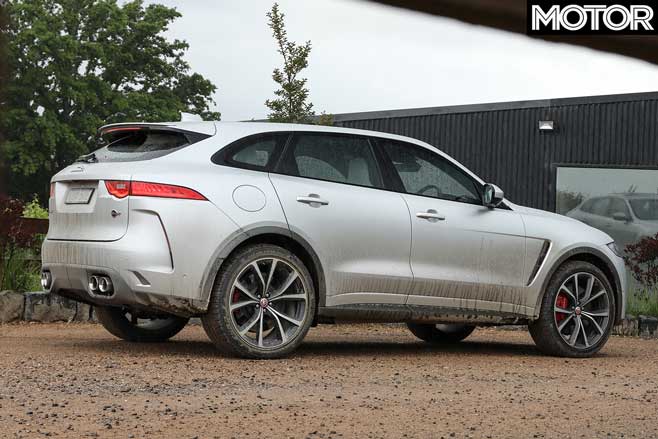
Thankfully the steering is more eager. It feels accurate, with a slightly elastic yet meaningful weight. It forges a good connection to the front wheels. There’s also a fair amount of grip to power out of corners. But the F-Pace SVR feels just a tad too doughy or soft to be taken seriously. It’s like a big lazy V8 muscle car trapped inside an SUV body.
No such problem in the X3 M. It feels like a sports wagon, only with a full cargo load, so it tackles corners with a wider and lower stance than the other two. It’s clearly more capable, no matter what type of surface you choose. Yet it’s clinical in the way it picks apart its, erm, competition.
The X3 M’s gearbox is remarkably obedient, snapping through shifts, while the paddles, as uninspiring as they look, feel crisp and immediate. The S58’s grumbly, high-revving exhaust note is disappointingly toned down inside, where it sounds a touch artificial.
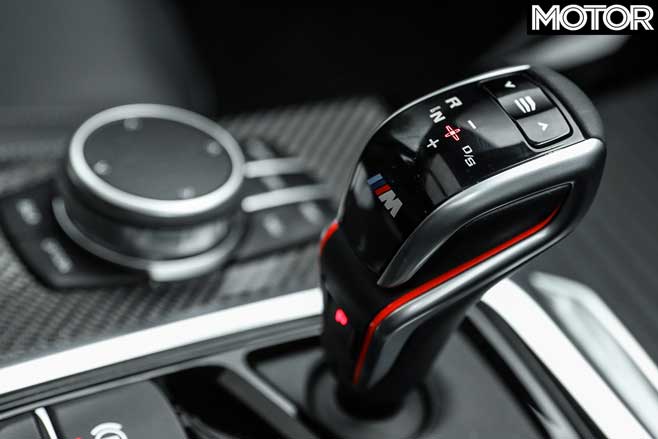
Then there is the number of ways to program its modes. It’s almost overwhelming. For instance, the transmission shift program has three modes, as does the steering weight, ESP, damper stiffness and engine response. The xDrive, meanwhile, offers 4WD or 4WD Sport for a change to a more rearward bias. You feel trapped inside a race engineer’s laptop when you just want to get on and drive the thing.
Granted, the M1 and M2 buttons on the steering wheel allow you to preset combinations, one for winding roads and another for straights, perhaps. But we’re not sure all this customisation really broadens the X3’s talents.
The adaptive dampers are always firm and the steering weight feels best in Sport. The shift program should just always match the level of engine response. And neither does 4WD or 4WD Sport make any measurable difference in a straight line – as we’re about to discover at Heathcote Raceway.
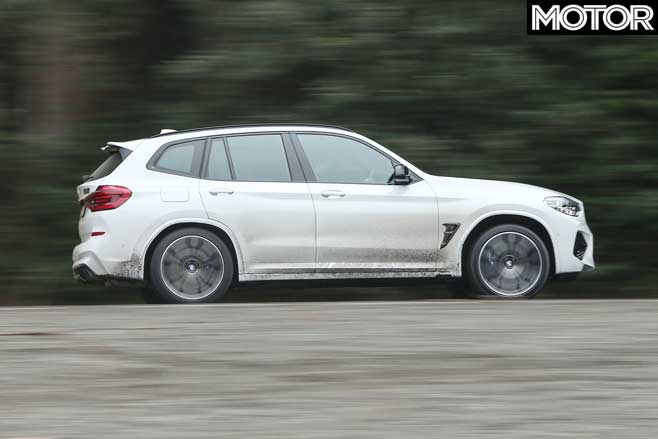
Switch the X3 M into its most aggro settings. Hold the brake. Add throttle. Nothing more than 2700rpm, though, or you will break the stall. Release the brake and it lunges forward, hitting 100km/h in 4.1 seconds and the quarter mile’s end in 12.1, with consistency typical of its clinical nature.
ESP on or off, 4WD Sport or not, it repeats the result again and again, the only difference being how much rubber it leaves behind on the launch pad. But we reckon there’s more time to find in manual mode.
The X3 M upshifts at around 7000rpm, meaning second gear leaves 200rpm on the table. These extra revs would let it hit 100km/h without a shift. But because the engine spins so fast, despite being undersquare and geared long, it’s tricky to grab the next gear without hitting the limiter.

Even the X3 M’s gearbox would be an upgrade for the SVR’s, though. We’ll explain why in a second. First, let’s get the big SVR off the line. Tickle the throttle to 1500rpm, then stomp the gas. It squats and takes off with its nose in the air, like a massive oblong powerboat, and you have to fight to keep it straight as the steering lightens.
Soon after, it nails a 4.2sec 0-100km/h sprint and a 12.2sec lunge down the quarter-mile. That’s a tenth slower than the X3 M in both measurements, even with a higher power-to-weight ratio. But its modest 187.6km/h trap speed is even more baffling, as it’s packing the most horsepower here.
We’re guessing the horses in Warwickshire, England, are either malnourished or the SVR’s short gearing is preventing it from winding out its stonk. Its speed in gears reveals that much; third arrives at 91km/h and fourth at 136km/h, whereas the X3 can run to 100 and 150 respectively.
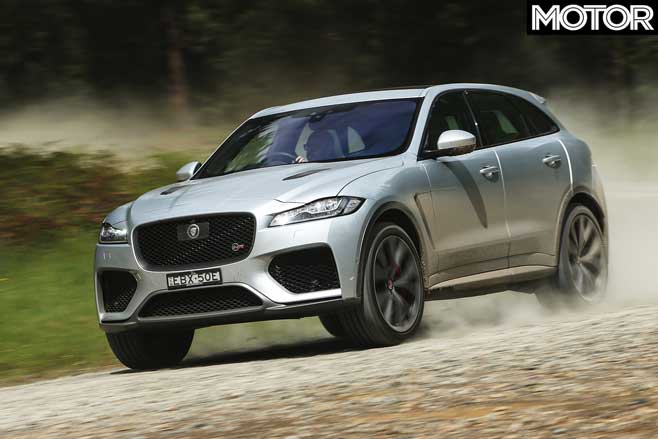
The Stelvio’s speed in gears are even shorter again compared to the SVR, but some tyre punctures earlier in the test ruled it out of a direct comparison on the strip. Not to leave it out from the battle completely, though, we’ve deferred to its acceleration times from recent Performance Car of the Year testing, when it showed jaw-dropping speed on The Bend Motorsport Park circuit’s main straight.
Zero to 100km/h from rest on that occasion took just 3.79 seconds and the quarter-mile was done in 11.94 seconds. Yeah, that was a different day and a different track, but it’s at least two-tenths clear of its rivals in both measurements. And it’s believable, not least for a couple of things.
For one, it’s relatively light at 1830kg. Combine that with short gearing, an almost frictionless torque converter and its free-revving, torque-rich V6 and you’re left with a recipe for a rocket. But certainly, not just the Stelvio, for all three cars it’s worth looking at the numbers and letting them sink in. All three are serious traffic light scalp-takers.
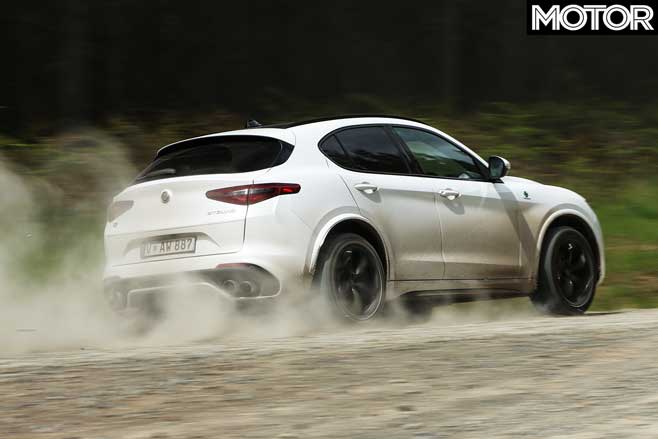
If only everything else on the Stelvio worked. Its windows have refused to go up or down for the entire duration of our test. And the wing mirrors sporadically bow out from service. These suspicions about its reliability only undermine the good things, like its ride, visibility and smooth powertrain. But that’s sort of par for the course in its low-rent interior.
Like the Giulia that inspired its cabin design, the Stelvio’s interior surface finishes and the gear lever’s ghastly backlighting drag down its premium ambience. Mind you, the carbonfibre seats and steering wheel spoke inject some excitement into the cabin, but also bump the price.
The Sparco seats cost an extra $7150 for the pair, while the steering wheel adds another $650. Add some fancy tri-coat paint for $4500 and our Stelvio rolls up at $162,250 – the most expensive on test. It’s a shame, because the Stelvio Q is a quick and pretty SUV that’s a good alternative to the typical choices.

Then there’s the Jaguar, which starts as an absolute bargain at its base price. But with an active safety pack, panoramic roof, 22-inch wheels, a head-up display and a few other things you would expect as standard (like DAB+), its price inflates from $142,262 before on roads and options to $156,981 as tested. You get some cool front seats for the dosh, and the decent cabin drowns out unwanted noises while welcoming the nice ones – like the engine’s roar. That V8 would make anyone forget they’re driving a family SUV every time they sink the throttle.
Overall, the Jaguar is a charismatic, charming and good-looking beast. However, while its aggressive looks are almost worth the price of admission alone, the monstrous 22-inch wheels spoil its ride and deflect on most surfaces with no improvement to handling. Yes, it’s an SUV, but the seating position is just too high. In contrast to the X3 M Competition’s.
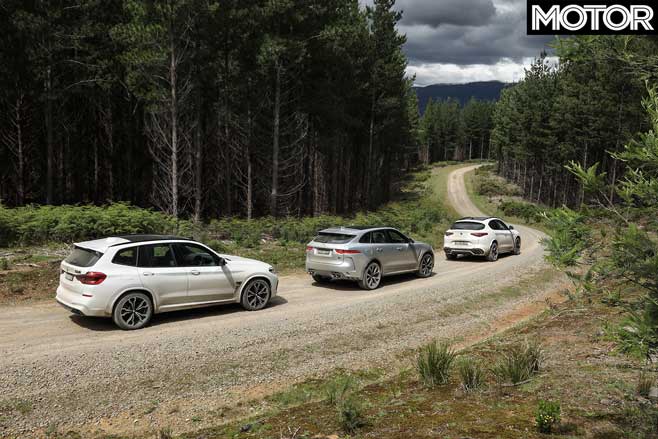
Speaking of the X3 M, yes, it rides firm, and the drive modes are frustrating. But you sit nice and low, at least for an SUV, and on the most supportive seats, where you’ll slowly submit to its various talents. For one, without many options to tick, except seat heating and rear seat adjustment, the X3 M Competition is only $1000 dearer than its list price – set at $157,900. Then there’s what it does so well. It’s freakishly fast from point to point, an encouraging handler, consistent in a straight line and rarely drops the ball in terms of ergonomics or refinement.
At the end of the day, the X3 M is the car we’re most drawn to. And, without a ridiculous price difference, it’s the one we’re staying in. So ring the bell on round one, BMW is the winner. It earns the chance to prove its mettle against Mercedes-AMG and Porsche – stay tuned.
Fast Facts
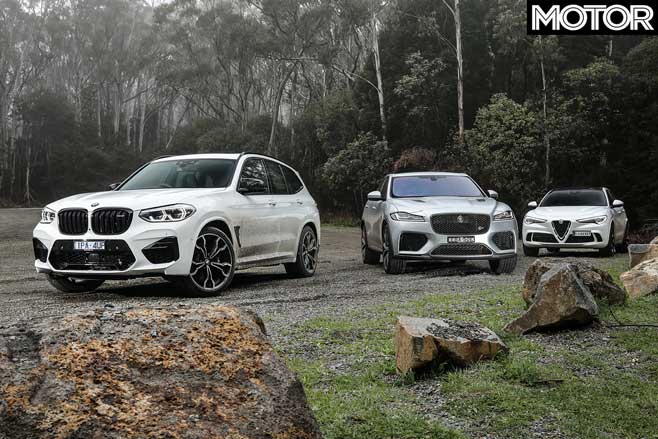
| u00a0 | BMW X3 M Competition | Jaguar F-Pace SVR | Alfa Romeo Stelvio Q |
| Body | 5-door, 5-seat SUV | ||
| Drive | all-wheel | ||
| Engine | 2864cc inline-6, DOHC, 24v, twin-turbo | 5000cc V8, DOHC, 32v, supercharger | 2981cc V6, DOHC, 24v, twin-turbo |
| Bore x Stroke | 84.0 x 90.0mm | 92.5 x 93.0mm | 86.5 x 82.0mm |
| Compression | 9.3:1 | 9.5:1 | 9.3:1 |
| Power | 375kW @ 6250rpm | 405kW @ 5500-6500rpm | 375kW @ 6500rpm |
| Torque | 600Nm @ 2600-2950rpm | 680Nm @u00a02500-5500rpm | 600Nm @ 2500-5000rpm |
| Power/Weight | 190kW/tonne | 203kW/tonne | 205kW/tonne |
| Transmission | 8-speed automatic | ||
| Weight | 1970kg | 1995kg | 1830kg |
| Suspension (f) | struts, adaptive dampers, anti-roll bar | double wishbones, adaptive dampers, anti-roll bar | |
| Suspension (r) | multi-links, adaptive dampers, anti-roll bar | ||
| L/W/h | 4726/1897/1669mm | 4737/2071/1670mm | 4701/1955/1681mm |
| Wheelbase | 2864mm | 2874mm | 2818mm |
| Tracks | 1617/1602mm (f/r) | 1648/1666mm (f/r) | 1622/1675mm (f/r) |
| Steering | electrically assisted rack-and-pinion | ||
| Brakes (f) | 395mm ventilated/drilled discs, 4-piston calipers | 395mm ventilated discs, 4-piston calipers | 360mm ventilated/drilled discs, 6-piston calipers |
| Brakes (r) | 370mm ventilated/drilled discs, single-piston calipers | 396mm ventilated discs, single-piston calipers | 350mm ventilated/drilled discs, 4-piston calipers |
| Wheels | 21.0 x 9.5-inch (f); 21.0 x 10.0-inch (r) | 22.0 x 9.5-inch (f); 22.0 x 10.5-inch (r) | 20.0 x 9.0-inch (f); 20.0 x 10.0-inch (r) |
| Tyre Sizes | 255/40 ZR21 102Y (f); 265/40 ZR21 105Y (r) | 265/40 ZR22 106Y (f); 295/35 ZR22 109Y (r) | 255/45 R20 (f); 285/40 R20 (r) |
| Tyres | Michelin Pilot Sport 4S | Pirelli P Zero | Pirelli P Zero AR |
| Price | $157,900 ($158,900 as tested) | $142,262 ($156,081 as tested) | $149,9000 ($162,250 as tested) |
| Pros | All-round athlete; standard kit; seating position | Looks; noise; charm | Supple and sharp chassis; effortless surge |
| Cons | A bit clinical; high base price | Heavy; high; slower than expected | Reliability suspicions; numb brakes |
| Rating | 4 out of 5 stars | 3.5 out of 5 stars | 3.5 out of 5 stars |
The Strip
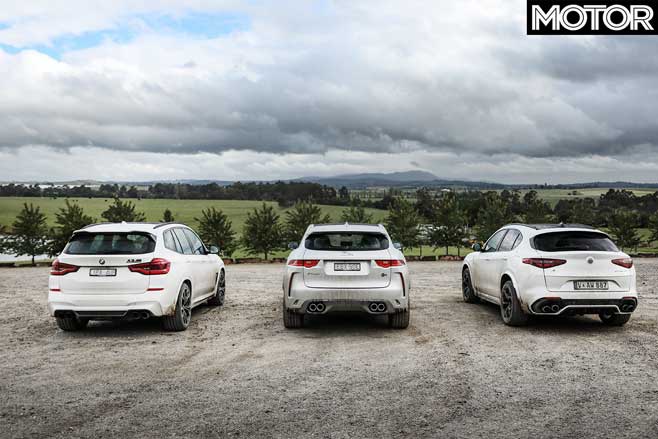
| u00a0 | BMW X3 M Competition | Jaguar F-Pace SVR | Alfa Romeo Stelvio Q |
| 0-10km/h | 0.27sec | 0.30sec | – |
| 0-20km/h | 0.62sec | 0.63sec | – |
| 0-30km/h | 1.04sec | 0.96sec | – |
| 0-40km/h | 1.37sec | 1.32sec | – |
| 0-50km/h | 1.71sec | 1.68sec | – |
| 0-60km/h | 2.10sec | 2.07sec | – |
| 0-70km/h | 2.57sec | 2.57sec | – |
| 0-80km/h | 3.04sec | 3.03sec | – |
| 0-90km/h | 3.54sec | 3.54sec | – |
| 0-100km/h | 4.11sec | 4.21sec | 3.79sec |
| 0-110km/h | 4.75sec | 4.84sec | – |
| 0-120km/h | 5.41sec | 5.52sec | – |
| 0-130km/h | 6.08sec | 6.21sec | – |
| 0-140km/h | 6.82sec | 7.04sec | – |
| 0-150km/h | 7.69sec | 7.92sec | – |
| 0-160km/h | 8.60sec | 8.85sec | – |
| 0-170km/h | 9.58sec | 9.84sec | – |
| 0-180km/h | 10.71sec | 11.13sec | – |
| 0-190km/h | 12.05sec | n/a | – |
| 0-400m | 12.10sec @ 190.39km/h | 12.20sec @ 187.55km/h | 11.95sec @ 191.50km/h |
| 80-120km/h (Drive) | 2.32sec | 2.51sec | 2.30sec |
| 100-0km/h | 33.47m | 35.16m | 35.6m |
| Speed in Gears | |||
| 1st | 64km/h @ 7200rpm | 61km/h @ 6600rpm | 54km/h @ 7200rpm |
| 2nd | 100km/h @ 7200rpm | 91km/h @ 6600rpm | 84km/h @ 7200rpm |
| 3rd | 150km/h @ 7200rpm | 136km/h @ 6600rpm | 125km/h @ 7200rpm |
| 4th | 187km/h @ 7200rpm | 172km/h @ 6600rpm | 156km/h @ 7200rpm |
| 5th | 245km/h @ 7200rpm* | 223km/h @ 6600rpm* | 204km/h @ 7200rpm* |
| 6th | 280km/h @ 6275rpm* | 283km/h @ 6510rpm* | 268km/h @ 7200rpm* |
| 7th | 280km/h @ 5155rpm* | 283km/h @ 5450rpm* | 285km/h @ 6300rpm* |
| 8th | 280km/h @ 4015rpm* | 283km/h @ 4340rpm* | 285km/h @ 4910rpm* |
Heathcote Raceway, 21.5˚C, dry. Driver: Louis Cordony *Manufacturer’s claim Official timing supplier: www.vboxaustralia.com.au






